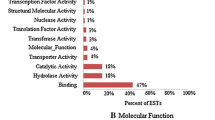Abstract
Two subtracted cDNA libraries ofDunaliella salina (Volvocales, Chlorophyceae) under different hyperosmotic shock were constructed using the suppression subtractive hybridization (SSH) method. The mRNA isolated from algae grown without stress was used as a “driver”, and the mRNAs isolated from algae 16 h (short-term treatment) or 7 d (long-term treatment) after salt stress were used as “testers”. The differentially expressed cDNA fragments inD. salina under salt stress were identified by screening these 2 libraries. Two cDNA fragments,D27 andD114, were identified from clones pL27 and pL114 after the long-term treatment. Three cDNA fragments,D21, D39, andD88, were identified from clones pSh21, pSh39, and pSh88 after the short-term treatment. The homology analysis revealed that D27 was highly similar (91%) to the subunit V of PS I reaction center inChlamydomonas reinhardtii. D21 was similar to fructose-1,6-diphosphate aldolase (78.4%). After searching GenBank with the sequences ofD39, D88, andD114, no similar sequences were found. Northern analysis revealed that the expression levels of all 5 cDNAs were increased significantly after salt stress. This means that SSH can be used in cloning differentially expressed cDNAs inD. salina under salt stress. The expression ofD27, D21, andD88 wasde novo induced by salt stress, and the expression ofD114 andD39 was increased from a relatively lower level; this indicates that all 5 cDNAs might exert an influence on the alga under hyperosmotic shock.
Similar content being viewed by others
Abbreviations
- CTCK:
-
C-terminal cystine knot
- FDP:
-
fructose-1,6-diphosphate
- SSH:
-
suppression subtractive hybridization
References
Ben-Amotz A and Avron M (1973b) The role of glycerol in the osmotic regulation of the halophilic algaDunaliella parva. Plant Physiol 41: 875–878.
Chapin FS (1991) Integrated responses of plants to stress. BioSci 41: 29–36.
Davis MM, Cohen DI, Nielsen EA, Steinmetez M, Paul WE, and Hood L (1984) Cell-type-specific cDNA probes and the murine I region: The location and orientation of Ad alpha. Proc Natl Acad Sci USA 81: 2194–2198.
Diatchenko L, Lau YFC, Campbell AP, Chenchik A, Moqadam F, Huang B, Lukyanov S, Lukyanov K, Nadya Gurskaya N, Eugene DS, and Siebert PD (1996) Suppression subtractive hybridization: A method for generating differentially regulated or tissuespecific cDNA probes and libraries. Proc Natl Acad Sci USA 93: 6025–6030.
Duguid JR and Dinauer MC (1990) Library subtraction ofin vitro cDNA libraries to identify differentially expressed genes in scrapie infection. Nucleic Acids Res 18: 2789–2792.
Fisher M, Gokhman I, Pick U, and Zamir A (1996) A salt-resistant plasma membrane carbonic anhydrase is induced by salt inDunaliella salina. J Biol Chem 271: 17718–23.
Fisher M, Gokhman I, Pick U, and Zamir A (1997) A structurally novel transferrin-like protein accumulates in the plasma membrane of the unicellular green alga Dunaliella salina grown in high salinities. J Biol Chem 272: 1565–70.
Fisher M, Zamir A, and Pick U (1998) Iron uptake by the halotolerant alga Dunaliella is mediated by a plasma membrane transferrin. J Biol Chem 273: 17553–8.
Franzén LG, Frank G, Zuber H, and Rochaix JD (1989) Isolation and characterization of cDNA clones encoking Photosystem I subunits with molecular masses 11.0, 10.0 and 8.4 kDa fromChlamydomonas reinnhardtii. Mol Gen Genet 219: 137–44.
Hara E, Kato T, Nakada S, Sekiya S, and Oda K (1991) Subtractive cDNA cloning using oligo(dT)30-latex and PCR: isolation of cDNA clones specific to undifferentiated human embryonal carcinoma cells. Nucleic Acids Res 19: 7097–7104.
Hedrick SM, Cohen DI, Neilson EA, and Davis MM (1984) Isolation of cDNA clones encoding T cell-specific membrane-associated proteins. Nature 308: 149–153.
Johnson MK, Johnson EJ, MacElroy RD, Speer HL, and Bruff BS (1968) Effects of salts on the halophilic algadunaliella viridis. J Bacteriol 95: 1461–8.
Liu J, Liu J, Yuan Z, Qian X, Qian M, and Yang (2001) Isolation and identification of genes expressed differentially in rice inflorescence meristem with suppression subtractive hybridization. Chinese Science Bulletin 46: 98–101.
Sacco de Vries, Harry H, and Ton B (1998) Isolation of total and polysomal RNA from plant tissues. Plant Mol Biol Manual B6: 1.
Sadka A, Himmelhoch S, and Zamir A (1991) A 150 kilodalton cell surface protein is induced by salt in the halotolerant green algaDunaliella salina. Plant Physiol 95: 822–31.
Sambrook J, Fritsch EF, and Maniatis T (eds) (1989)Molecular Cloning, a Laboratory Manual, 2nd ed. Cold Spring Harbor Laboratory Press, New York.
Sargent TD and Dawid IB (1983) Differential gene expression in the gastrula ofXenopus laevis.Science 222: 135–139.
Yamada S, Komori T, Hashimoto A, and Imaseki H (2000) Differential expression of plastic aldolase genes in Nicotiana plants under salt stress. Plant Sci 154: 61–69.
Author information
Authors and Affiliations
Corresponding author
Rights and permissions
About this article
Cite this article
Zhang, XN., Qu, ZC., Wan, YZ. et al. Application of suppression subtractive hybridization (SSH) to cloning differentially expressed cDNA inDunaliella salina (chlorophyta) under hyperosmotic shock. Plant Mol Biol Rep 20, 49–57 (2002). https://doi.org/10.1007/BF02801932
Published:
Issue Date:
DOI: https://doi.org/10.1007/BF02801932




